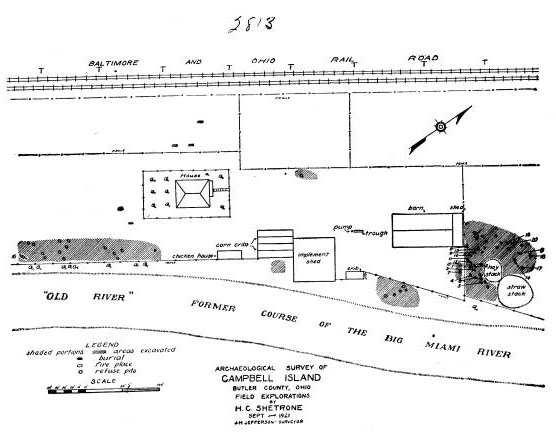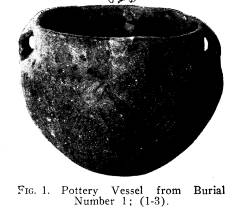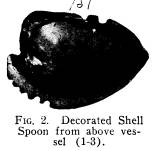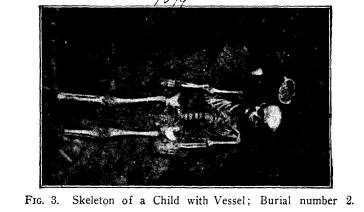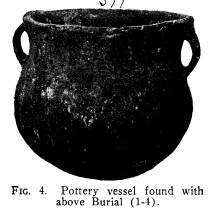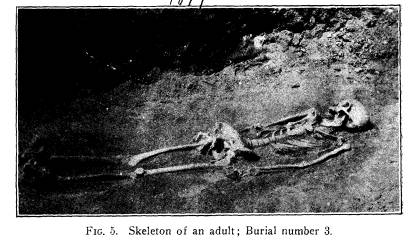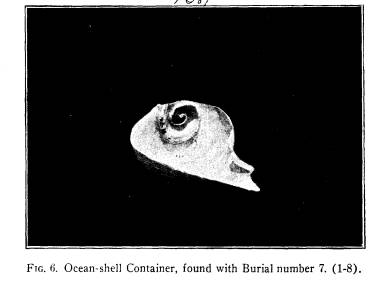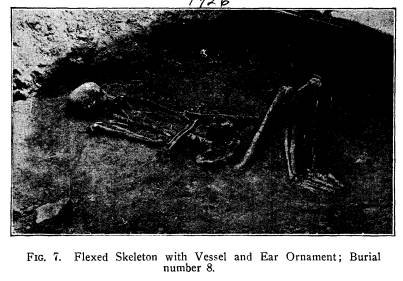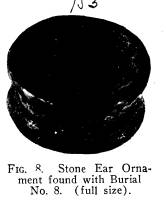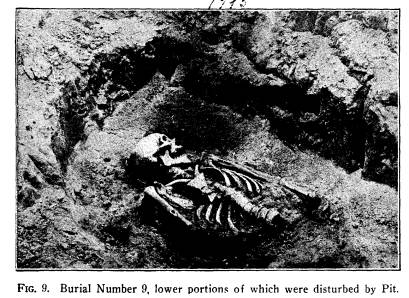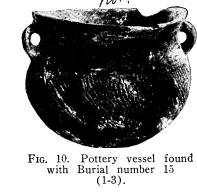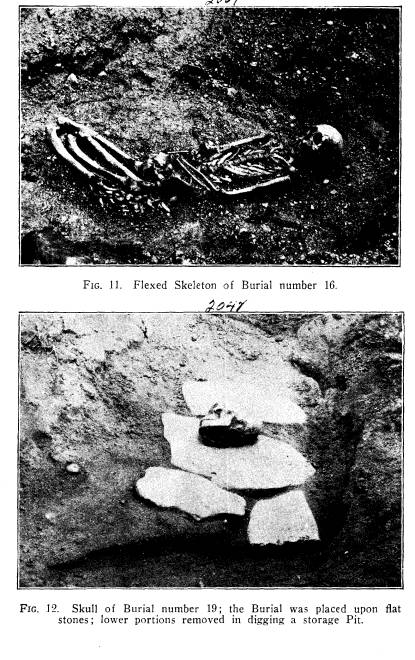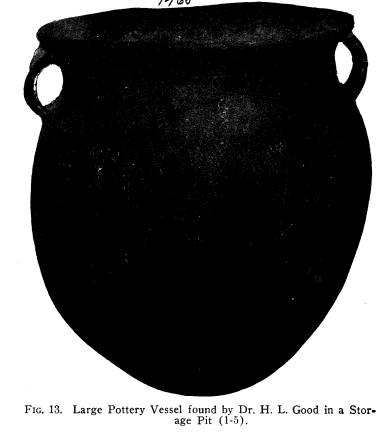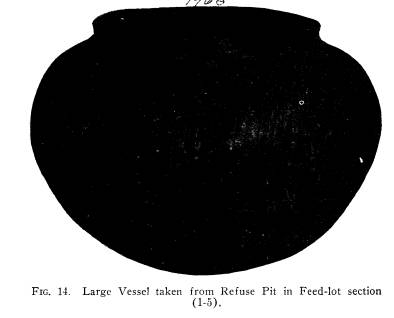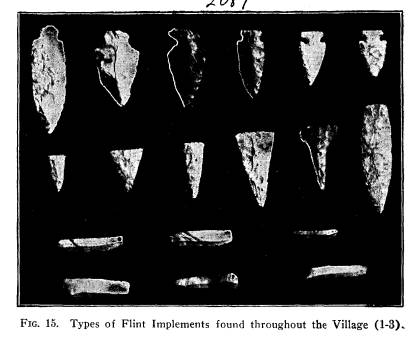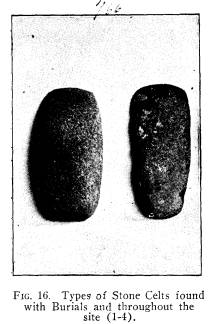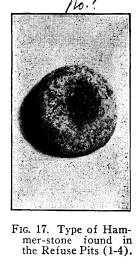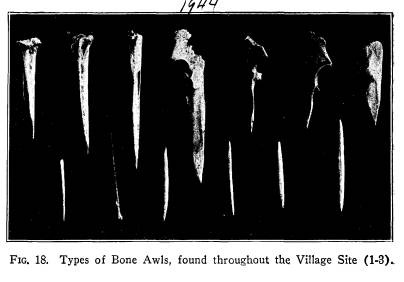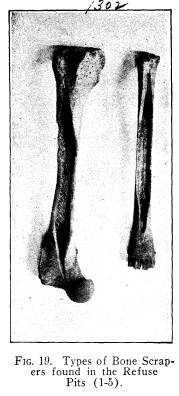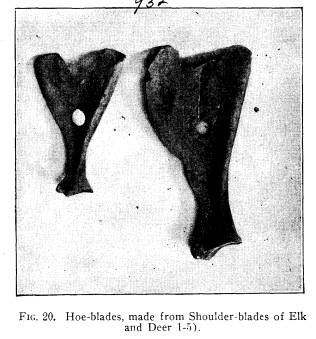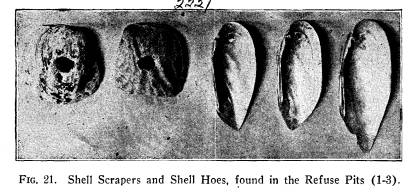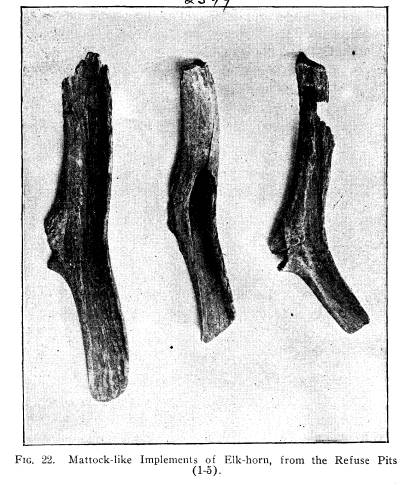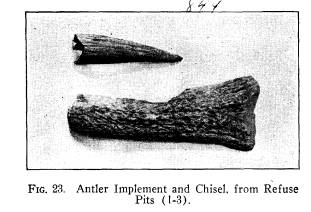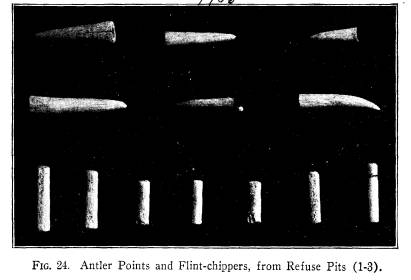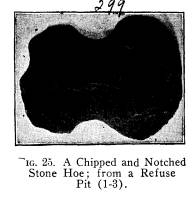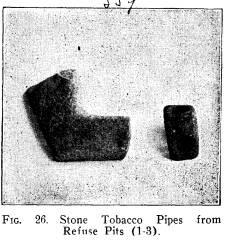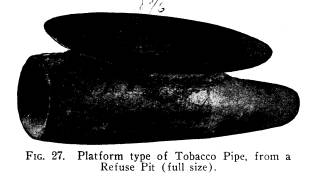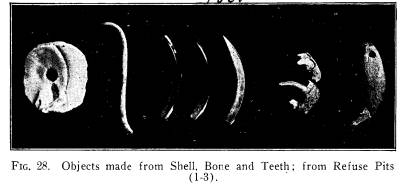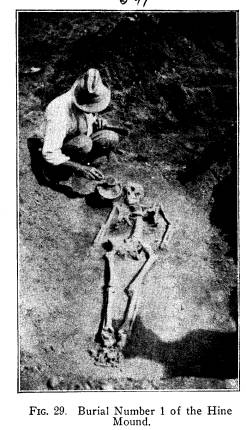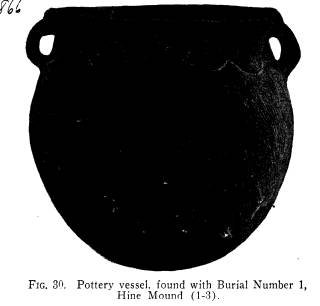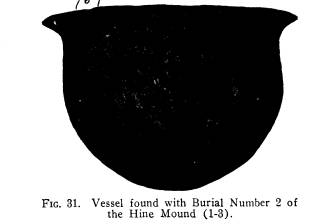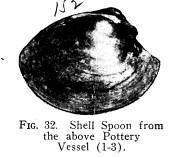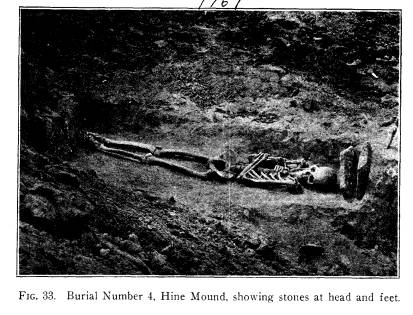Ohio History Journal
|
(434) |
EXPLORATIONS OF THE CAMPBELL ISLAND
VIL-
LAGE SITE AND THE HINE MOUND
AND VILLAGE SITE
BY H. C. SHETRONE,
Curator of Archaeology
TRANSMITTAL OF REPORT
JUNE 11, 1923.
PROFESSOR WILLIAM C. MILLS, Director,
Ohio State Archaeological and
Historical Museum.
MY DEAR PROFESSOR MILLS:
I have the honor to submit for your
approval a condensed
report of the examination of the
Campbell Island Village Site
and Hine Mound and Village Site,
located near Hamilton, Butler
County, Ohio.
Very truly yours,
H. C. SHETRONE,
Curator.
THE CAMPBELL ISLAND SITE
Late in the summer of 1921, Dr. H. L.
Good, of.
Hamilton, Ohio, brought to the
attention of the
Museum authorities the fact that marked
evidences of-
prehistoric human occupation exist on
what is known as
Campbell Island, in the Miami river at
the northern
edge of the city of Hamilton; and also
on the farm of
George Hine, five miles south of
Hamilton, on the west
side of the river. In view of the fact
that Dr. Good
had interested himself to the extent of
obtaining ex-
ploration privileges, the Director of
the Museum
deemed the occasion favorable for
obtaining definite in-
formation regarding the pre-historic
occupation of
(435)
436
Ohio Arch. and Hist. Society Publications
Butler county, and instructed the
writer to devote the
remainder of the exploration season to
the examination
of these sites.
Campbell Island was named for Lewis D.
Campbell,
the early owner of the land, who was an
uncle of Hon-
orable James E. Campbell, former
governor of Ohio,
and at this time president of the Ohio
State Archaeo-
logical and Historical Society. The
term island is some-
thing of a misnomer in this instance,
since the site is not
a true, or natural island, but owes its
origin to the fact
that early in the nineteenth century
the river, at a point
about three miles north of the city,
changed its course
and made for itself a new channel to
the westward. At
the south end of the island the stream
assumes its regu-
lar course, leaving the abandoned
channel to form the
eastern boundary of the thus created
island, of several
hundred acres extent.
It is upon the elevated southern
portion of the island
that remains of prehistoric human
occupation are
found. The site presents the anomaly of
being located
on the eastern side of the river,
whereas it formerly lay
on the west; and furthermore, as a
result of the flood
of 1913, it is covered by a deposit of
sand and silt to a
depth of from three to eight inches, so
that even where
the soil is under cultivation, not a
vestige of human
handiwork is to be seen, and surface
scrutiny would
give no hint of the underlying remains
of human occu-
pation.
The Campbell Island site, of limited
extent, at best,
is in great part occupied by the
farm-house with its
numerous barns and buildings, so that
only restricted
portions were available for
examination. The ac-
companying map shows the portions
excavated and
|
Explorations of the Campbell Island Village Site 437 suggests the location and extent of the remaining unex- plored areas. While the available strip lying to the south of the farm-house produced one burial and a number of storage pits, it was in the feed-lot to the northeast of the large barn that the more important re- sults were obtained. This area, it will be noted on the map, apparently comprises an oval space trending north and south for a distance of something over 200 feet and having a width of approximately 100 feet. The barn- lot which, owing to graded driveways and other ob- structions, could not be examined, apparently comprises practically one-half of the richest portion of the occu- pied area. The feed-lot area produced a total of 20 burials and 17 storage-pits; its southern extension, across the barn- lot, four pits and a fireplace; and the strip extending along the bank of the old river channel, to the south of the farm-house, one burial and 14 pits. There seems to have been no definite grouping of burials, nor any particular relationship between location of burials and |
|
|
|
storage or refuse-pits; however, it may be of significance that prac- tically all burials in the feed-lot area were ori- entated toward the east, northeast and south- east, as shown on the map. The burial found within the strip to the south of the farm- house had the head of |
|
the enclosed skeleton almost directly toward the west. |
|
438 Ohio Arch. and Hist. Society Publications The depth at which burials were placed varied from those lying partly within the plow-line to those placed a trifle more than two feet below the surface. |
|
|
|
Of the 21 burials uncovered, 15 lay extended at length upon the back; two lay upon the back with knees drawn upward; three were of undetermined position owing to recent disturbance; and one skele- ton, disarticulated and incomplete, was found in a refuse pit. Of the total of 21, 12 were adults, two |
|
adolescents, and seven were children ranging from in- fancy to ten years of age. Five of the 21 had pottery vessels placed with them, while four others were accom- panied by minor artifacts. Of the total number of burials, one had been disturbed by the depositing of a later burial, and two had been partly displaced in the construction of storage-pits. A single burial was par- tial, indicating re-burial. THE BURIALS IN DETAIL Burial Number 1 -- This grave contained the skele- ton of a child of about four years of age, extended upon the back, with head almost due east; with it was an earthenware pot (Fig. 1) of about three pints capacity, having four handles. Within the pot, was a mussel- shell spoon (Fig. 2) decorated with notches cut upon its edges. Burial Number 2 -- Skeleton of a child (Fig. 3) of approximately five years old, extended upon the back with head toward the east. A pottery-vessel (Fig. 4) of one quart capacity, having two handles and a scal- |
|
Explorations of the Campbell Island Village Site 439 loped rim, lay alongside the skull at the right. This vessel contained a plain mussel-shell spoon. |
|
|
|
Burial Number 3 -- Skeleton of an adult (Fig. 5), extended upon the back, with head toward the north- east. At the abdominal region was found a triangular |
|
|
|
arrow-point of drab flint. This burial and the two preceding ones were at a depth of two feet below the surface. Burial Number 4 -- An adult skeleton, appar- ently buried extended up- on the back, with head a trifle north of east. The original burial lay only one foot below the sur- |
|
face, but bones of the legs and feet had been re- moved in digging the grave for burial Number 3, and were found at a depth of two feet below the surface, beneath the skeleton of the last-named burial. |
|
440 Ohio Arch. and Hist. Society Publications Burial Number 5 -- Partial skeleton of an adult,. found deposited in refuse pit Number 3. Burial Number 6 -- Skeleton of an infant, badly de- composed; placed extended upon the back, with head toward the northeast. No artifacts. |
|
|
|
Burial Number 7 -- Just across the fence dividing the feed-lot from the barnyard and within the latter, there had been noted a year or two previously, a burial, from which workmen, in re-setting the fence, had re- moved a shell container. As the burial had not been further molested, it was felt that so small an encroach- ment upon the forbidden barnyard area was justified, and the skeleton accordingly was exposed. The burial was that of an adult, extended horizontally, with head toward the southeast. Alongside the left forearm lay a perforated canine tooth of the black bear. The shell container, now in the collection of Dr. H. Lee Good, of Hamilton, measures 11 inches in length and is made from the Fulgur perversum. It is shown as Fig. 6. |
|
Explorations of the Campbell Island Village Site 441 Burial Number 8 -- This grave contained the skele- ton of a youth of perhaps 16 years, and was one of the more interesting of the several uncovered. It lay upon the back, with head a trifle south of east, and with the knees drawn upward and backward, as shown in the |
|
|
|
cut, Fig. 7. The depth of this burial was so slight that the skull was but 10 inches, and the knees but seven inches, below the surface. At the pelvis lay a small earthenware pot, of less than one quart capacity and without handles. The type of this vessel, as well as its decorative imprint, is somewhat different from the typical vessels of the site. Alongside the left ear was found a short spool-shaped ear ornament (Fig. 8) made from soft reddish stone, closely resembling both in size and form the spool-shaped ear ornaments of copper found with the burials of the Hopewell culture group. |
|
442 Ohio Arch. and Hist. Society Publications Burial Number 9 -- Adult skeleton, presumably placed at length upon the back, head toward the north- |
|
|
|
east. An interesting feature of this burial is the fact that a subsequently constructed storage pit had resulted |
|
in the displacement and removal of the lower portions of the skele- ton, as shown in the cut, Fig. 9. The burial was at a depth of two feet. Burial Number 10 -- An in- complete adult skeleton, placed at length upon the back with head toward the east; skull, cervical vertebrae and feet bones absent; depth of burial, a trifle less than two feet. |
|
|
|
Burial Number 11 -- Skeleton of an infant, ap- |
|
Explorations of the Campbell Island Village Site 443 parently only a few weeks old; extended burial, head toward the east. Burial Number 12 -- Adult skeleton, extended upon back with head toward the northeast; burial so near the surface that cultivation had dislodged the skull and other bones. |
|
|
|
Burial Number 13 -- Skeleton of a child, extended burial with head toward the southeast; had been dis- turbed by the plow. Burial Number 14 -- Adult skeleton, placed hori- zontally at length, head toward the southeast. Burial Number 15 -- Skeleton of a youth, extended upon the back with head to the northeast. An interest- ing vessel (Fig. 10) of about three pints capacity, lay at the right side of the skull. |
|
444 Ohio Arch. and Hist. Society Publications Burial Number 16 -- Skeleton of an adult, lying upon the back with knees drawn backward and upward, and with left forearm across the body. The orientation of this skeleton was unusual for the site, the head being toward the west. The skeleton presented an interesting pathological condition of the teeth (Fig. 11). |
|
|
|
Burial Number 17 -- In- fant, extended burial, with head to the southeast; at the pelvis reposed two triangular arrow-points of drab-colored flint. Burial Number 18 -- Adult, badly decomposed as a result of shallow grave; ex- tended burial, with head to- ward the southeast. |
|
Burial Number 19 -- This grave furnished the sec- ond example for the site of a burial disturbed by the construction of a storage-pit. In this instance the body had been deposited upon large slabs of limestone, and the digging of the pit had removed the lower one-half of the skeleton, including the pelvis. The cut, (Fig. 12) shows the slabs in place with the skull as it lay when found, but through an oversight, the remaining skeletal parts were removed before the photograph was made. The edge of the pit, as it impinged upon the burial, may be seen in the cut. Burial Number 20 -- Skeleton of an adult, extended upon the back, with head toward the southeast; this skeleton lay in a very shallow grave and was badly de- composed. With it were several bone implements, in- cluding an awl, made from a leg-bone of the deer. |
|
Explorations of the Campbell Island Village Site 445 200/ |
|
|
446
Ohio Arch. and Hist. Society Publications
Burial Number 21 -- Skeleton of an infant, ex-
tended upon the back, head to the
northeast; shallow
grave and badly decomposed skeletal
remains.
THE STORAGE-PITS
The storage pits, cache pits or refuse
pits, as they
are variously termed, as found in the
Campbell Island
site, were quite similar to those found
in other sites of
the culture group in Ohio, although,
owing to the lesser
importance and size of the site under
consideration,
they perhaps were not so large nor so
carefully con-
structed. The largest of the 35 pits
examined measured
three and one-half feet in diameter at
the top, was five
feet in depth, and tapered slightly
inward to the flat
bottom. It was filled with the
characteristic strata of
earth, organic remains, sand and so
forth, while upon
the bottom, to a depth of 10 inches,
lay a deposit of
charred shelled corn and beans. Almost
a bushel of
the intermixed corn and beans was
removed and was
found to be in a very gratifying
condition, the greater
part of the grains retaining their
natural forms.
Numerous animal and bird bones were
taken from the
upper strata of this pit, and many
fragments of the
characteristic pottery-ware were recovered.
The refuse pits were the principal
source of the
implements, ornaments and
pottery-fragments obtained
from the site, among the last-named
being an extremely
large and interesting broken vessel
which afforded a
complete restoration, and a second
vessel, almost as
large, which had been fractured and
dumped into the
pit.
In the portion of the site extending to
the southward
of the barnyard there was disclosed a
fire-place, five
Explorations of the Campbell Island
Village Site 447
feet in diameter. This was not a
specialized structure,
such as occasionally are found in sites
of the culture
group, but merely an open fire-bed,
occupying the level
unmodified surface of the ground.
Within the ashes
resulting from its use were found
fragments of pottery-
ware, broken bone scrapers,
mussel-shells and animal
bones.
ARTIFACTS FROM THE SITE
Pottery-ware -- Potsherds and fragments of pots,
mostly from the large handled cooking
vessels, were
everywhere in evidence throughout the
site. Fig. 13
illustrates an unusually interesting
vessel, of large size,
which was found by Dr. H. L. Good,
previous to these
explorations, where it had been partly
exposed through
caving off of the terrace in which it
lay. Apparently
the vessel had been thrown into a pit,
upon being
broken, the break being in the nature
of a vertical
crack or split, thus leaving the pot in
two practically
entire sections. It was presented by
Dr. Good to the
Museum, where the restoration was made.
The vessel
measures 17 inches in height and 14 1/2
inches in diameter.
A second extremely large and very
unusual vessel,
taken by our survey from a pit in the
feed-lot section,
is shown as Fig. 14. This pot, which
has the extraor-
dinary measurements of 17 3/4 inches in
diameter and 12 3/4
inches in height, has a capacity of
something near five
gallons. The walls average less than
one-eighth of an
inch in thickness and in places are as
little as one-
twelfth of an inch. The entire vessel
weighs a few
ounces over five pounds. It will be
noted that in type,
as well as in size, this vessel does
not conform to the
characteristic pottery-ware of the
culture group. It is
Vol. XXXII -- 29.
|
448 Ohio Arch. and Hist. Society Publications without handles, its horizontal measurement as com- pared with the vertical is much greater, and the char- acter of its component material is different. Instead of the rather coarse clay, tempered with granulated shell, |
|
|
|
which usually burns to a reddish hue, this vessel is made from a very fine and smooth slip, without visible tempering material, and as a result of firing has a dark brown to black color. Tests of fragments show, despite their thinness, extreme strength and resistance to use |
|
Explorations of the Campbell Island Village Site 449 and exposure. The vessel apparently had been cracked or broken, and the entire residue thrown into the refuse pit. Several pieces were as much as one foot across, and by careful search all except some small fragments were recovered, making possible a complete restoration. The vessel is simply decorated around its greater cir- cumference by incised or impressed vertical and hori- |
|
|
|
zontal lines, arranged somewhat shield-like as to pat- tern. All traces of fabric or basketry container, that may have been used in its manufacture, have been re- moved. Professor C. B. Harrop, of the Department of Ceramic Engineering of Ohio State University, to whom the vessel was submitted for examination, pro- nounces it as most exceptional from a primitive ceramic viewpoint. It was a considerable achievement, he points |
|
450 Ohio Arch. and Hist. Society Publications out, for the primitive potter to be able to fashion so large a vessel with so comparatively thin walls, and to retain its form until firing could be effected. Flint Implements -- Implements chipped from flint comprise the projectile points both of the stemmed-and- notched and the triangular unnotched varieties; knives and scrapers of the notched and unnotched lanceolate types; drills or perforators; and the flake knives. For the last-named, the Flint Ridge variegated flint mostly was used, while in the preceding forms the material for the most part is the southern Ohio gray and drab chert. None of the types present differences over those from other sites of the culture. Representative specimens are shown as Fig. 15. |
|
|
|
Explorations of the Campbell Island Village Site 451 Stone Implements -- The celt, or un-grooved axe (Fig. 16) and the common hammerstone, or hand- |
|
|
|
hammer, (Fig. 17), com- prise practically the only types of pecked and ground stone implements found in the site. Celts were not numerous, but the hammer-stones were fairly abundant. Implements of Bone -- The principal type made from bone found in the site are the awls, the elon- gated scrapers or beam- ers, and the hoes or dig- ging implements. The bone awls are mainly of three types -- those made from the ulna of the wild |
|
turkey and other large birds; those fashioned from the metapodial (and occasionally from other leg-bones) of the deer; and those made from splints and split strips of various animals and bird bones. These forms are shown in the cut, Fig. 18. A single example of the long curved bodkin-like needle, with the perforated base for ac- commodation of the thread, was found. Specimens of the scraper -- one made from the metapodial bone and one from the femur of the deer, are shown in Fig. 19. The shoulder blades of the deer and the elk appear to have been the favorite bones used by inhabitants of the site as hoes. Not infrequently these are perforated, |
|
452 Ohio Arch. and Hist. Society Publications apparently to facilitate attachment of handles, as shown in the cut, (Fig. 20). |
|
|
|
Shell Implements--Hoes, scrap- ers and spoons, or ladles, are the three forms commonly made from shell, as found in the Campbell site. The last-named is illustrated in con- nection with the description of pot- tery vessels found with burials; the hoes and scrapers are shown as Fig. 21. In the former, the cutting edge of the implement often is strikingly worn, showing energetic use; in the scrapers, as will be noted, the mar- gin of the shell is ground away to form a straight or slightly curved line at the point of contact with the |
|
object or material to be shaped. |
|
|
|
Explorations of the Campbell Island Village Site 453 Implements of antler -- The most striking type of antler implement found in the site is the large mattock- like digging implement, made from the beam or a cor- respondingly rather large section of elk antler. These are illustrated in Fig. 22, and are entirely similar to |
|
|
|
those found at the Madison- ville site. The lower portion of the implement, correspond- ing to the cutting edge, is cut partly away, to leave a curved bit, while the projection higher up, resulting from the removal of a tine, apparently served as a stay for the thong which, passing around it, helped to secure the handle to the poll of the implement. Other forms of antler implements are the chisel and the hollow point (Fig. 23), the flint-chipping implement and the arrow- point shown as Fig. 24. An interesting digging implement, in the form of a hoe, is shown as Fig. 25. This notched speci- men, chipped from an argil- laceous rock, is the only one |
|
of the kind found in the site. Tobacco Pipes -- But three specimens of pipes were found in the site -- two of them, a small cubical form and an unfinished L-shaped specimen, both of sand- stone, (Fig. 26), taken by our survey from refuse pits, and a finely made platform type, (Fig. 27), taken from |
|
454 Ohio Arch. and Hist. Society Publications a pit located beneath the straw-stack by Dr. H. L. Good, subsequent to these explorations. The last-named is made of limestone. Other Specimens From the Site -- In Fig. 28 are shown a perforated shell disk, one and three-fourths inches in diameter; a polished splanchnic bone of the |
|
|
|
raccoon; three beaver tusks, used as chisels or knives; an ornament made from a section of the jaw of the gray wolf; and a perforated canine tooth of the black bear. A cache of 72 unfinished projectile points, of grayish- colored chert, was found in one of the refuse pits in the feed-lot. That the Campbell Island site was not a particularly prosperous settlement is indicated by the scarcity of ob- |
|
Explorations of the Campbell Island Village Site 455 jects of ornament, even the common bone bead, usually so abundant, being almost altogether absent. Animal and Bird Bones -- It was hoped that the buffalo might be identified among the skeletal remains found in the refuse pits of the site, but, although found at the Madisonville site, they were altogether lacking. Bones of animals and birds found and identified at the Campbell Island site are as follows: elk, deer, black bear, wolf, mountain lion, Indian dog, wild cat, gray fox, raccoon, beaver, otter, ground hog, skunk, opossum, gray squirrel, box turtle, wild turkey and wild duck. |
|
|
|
THE HINE MOUND AND VILLAGE SITE The Hine Mound and Village Site are located upon the farm of Mr. George Hine, about five miles south of Hamilton, in Ross township, Butler county, Ohio. They occupy a rather strategic position, the plateau-like terrace on which they are situated deriving natural pro- tection on the east from the declivitous descent to the Great Miami River, and on the south and southwest from an almost equally abrupt descent to the bed of a tributary stream from the northwest. Since the pre- |
|
456 Ohio Arch. and Hist. Society Publications historic occupation of the site, however, the Miami river, as at Campbell Island, has changed its course and |
|
|
|
now occupies a new channel a mile or more to the east- ward. After completion of the examination of the Camp- bell Island site, the survey spent ten days in a pre- |
|
Explorations of the Campbell Island Village Site 457 liminary examination of the Hine mound and site, with the results herewith recorded. In view of the fact that |
|
|
|
the latter site proved to be similar in every way to the Campbell Island site, and that both are attributable to the same culture group of Ohio aborigines, it is deemed |
|
|
|
458 Ohio Arch. and Hist. Society Publications proper to include the results of their examinations in the same report. According to information afforded by Mr. Hine, the present owner of the land, the Hine site must have been |
|
|
|
of considerable extent and importance. Mr. Hine de- clares that during the up- wards of a half century that he has lived upon the farm, and throughout the preced- ing years of cultivation by his father, at least one hun- dred skeletons have been dis- lodged by the plow, many of which were accompanied by |
|
pottery vessels. According to his observations -- and this is borne out by the examination made by our survey |
|
-- practically all buri- als were in extremely shallow graves. A number of graves which had been prac- tically eradicated by the plow were located, but none that lay deeper were to be found within the short time at our disposal. A few refuse pits, and a considerable area of refuse-bearing soil |
|
|
|
were examined with the result that a representative series of implements was obtained. Practically all the |
|
Explorations of the Campbell Island Village Site 459 types secured from the Campbell Island site were found, although in much fewer numbers. An interesting dis- covery was that of the entire skeleton of the Indian dog, |
|
|
|
which was found buried in the refuse deposit above referred to, at a depth of 15 inches below the surface. In connection with the Hine village site is a burial mound, which was found to be approximately 60 feet |
|
|
|
in diameter and slightly less than seven feet in height at its apex. There had been some doubt as to whether this elevation was an artificial mound or merely one of the gravel kames not uncommon in the vicinity. It was found to be artificial in its entirety, and to be con- |
|
460 Ohio Arch. and Hist. Society Publications structed of the earth and soil of the surrounding village. Occupation of the site had both preceded and followed the erection of the mound, as shown by habitation evi- dences and refuse pits on the original surface and by a grave dug into the structure near its apex. In view of the fact that as a rule burial mounds of the culture, where they are found in connection with habitations sites, contain many burials, it was expected that the Hine mound would yield profusely in skeletal |
|
|
|
remains. It proved to be an exception, however, in this re- spect, and was found to contain only five burials. Burial Number I -- At a distance of ten feet from the eastern margin of the mound was found Burial Number i. It was that of a young adult, the skeleton extended upon the back, with the head toward the northeast. The burial, as it was uncovered, is shown as Fig. 29. A fine pot- tery vessel, decorated with looped lines about the neck, lay |
|
Explorations of the Campbell Island Village Site 461 just above the right shoulder of the skeleton, while a well-made celt of argellite lay near the left foot. The vessel is shown as Fig. 30. Burial Number 2 -- This was the skeleton of an infant, and lay toward the southeastern circumference of the mound. The skeleton was extended with head toward the north. A fine pottery vessel, of three quarts |
|
|
|
capacity (Fig. 31) and decorated with a pleasing de- sign, lay at the left side of the head. A shell spoon (Fig. 32) was inside the vessel. Burial Number 3 lay southeast from the center of the mound. The skeleton, an adult, was extended, with head toward the north. It was unaccompanied by arti- facts. Burial Number 4, (Fig. 33), lay a short distance south of center, was extended upon the back with head |
|
462 Ohio Airch. and Hist. Society Publications to the north, and was placed one foot above the floor line. At the head and similarly at the feet, were placed two large slabs of fossil-bearing limestone. A single pearl bead was found at the skull. |
|
|
|
Burial Number 5 was that of a child which occupied a shallow grave near the top center of the mound. It had been disturbed by the plow, and the accompanying pottery vessel was badly broken. |
|
|
|
The only additional feature of the Hine mound was the occur- rence at approximately the cen- ter of its base or floor-line of up- wards of 100 limestone slabs, ranging from small and medium- sized to very large and heavy specimens. These covered a space of 10 by 12 feet and were |
|
laid without apparent order, some of them flat upon the surface and others on edge. These stone slabs, toward the south side of their extent, were in places placed one |
|
Explorations of the Campbell Island Village Site 463 above the other. Intermingled with the slabs were small quantities of ash and charred matter, apparently the result of burning of twigs and small branches. It was felt that an important burial would be found be- neath this pretentious structure, but careful examination of the underlying ground to a depth of several feet pro- duced no results. |
|
|
|
COMPARISONS AND CONCLUSIONS Examination of the Campbell Island site and of the nearby Hine site, though neither of them are extensive, add definitely to the accumulating evidence concerning the great Fort Ancient culture group in Ohio. While less than a quarter of a century ago but a single site of the group had been examined, there are now available published results of complete examinations of at least |
464
Ohio Arch. and Hist. Society Publications
a half-dozen important sites; and
whereas formerly
speculation busied itself in attempting
to attribute the
sites to one or another of the known
historic tribes or
nations, the evidence now is clear
that, along with
others yet to be explored, they
represent the habitation
sites of an important, populous and
widespread group
of our prehistoric population.
Perhaps the most gratifying result of
the examina-
tion of the sites covered by this
report is the establish-
ment of the fact that they may be
regarded as outposts
(or prototypes, as the case may be) of
the great settle-
ment at Madisonville. This conclusion
is based upon
the finding that not only are they
attributable to the
general culture group of which
Madisonville may be
accepted as the type, but that in the
matter of localized
or modified traits, as exhibited in
burial customs and
artifacts, they are altogether similar.
It is a logical supposition that
whatever may be
learned through archaeological research
regarding mi-
gration and chronology of this great
group, must be
mainly through the media of these
variations or sub-
traits of a common culture complex; for
should suc-
ceeding sites show no deviation from
nor addition to
the evidence already adduced, progress
would be slow
indeed. Without presuming to draw
conclusions as to
relative time of occupancy or migratory
movements, it
may be of interest, at this time, to
indicate the points
of similarity of the sites covered in
this report and the
Madisonville site, on the one hand; and
the apparent
close relationship between certain
others of the general
group, on the other.
The characteristic indicia of the Fort
Ancient
culture group are, of course, well
known. They alone
Explorations of the Campbell Island
Village Site 465
of the several distinct groups of the
territory have left
well-marked village sites. These sites,
often quite ex-
tensive, usually contain
both burial mounds and
cemeteries, as well as quantities of
debris and refuse,
disposed either in abandoned storage
pits or in midden
deposits; pottery-ware, stone, bone and
shell implements
and ornaments of distinctive types. It
is in the presence
or absence of any one or more of these
indicia, or in
variation shown in burial custom, type
of artifact or
common trait, that there may be found
similarities or
differences bearing upon the
inhabitants of the several
sites.
The examined sites and the order in
which they ap-
pear to be closely related, are: Madisonville and
Campbell Island (including the Hine)
sites; the Feurt
site and the Fox farm (Kentucky) site;
the Baum site
and the Gartner site.
The Madisonville1 and Campbell
Island Sites. Nat-
urally in a site so important and
extensive as that at
Madisonville, a comparatively long
period of occupa-
tion would be expected. This surmise
was fully veri-
fied in its exploration by the finding
of changes in
burial customs as between the earlier
and the later por-
tions of the site. Furthermore, it was
shown that oc-
cupation had extended to a date
sufficiently recent to
permit its inhabitants to come into
contact with Euro-
pean traders. The earlier part of the
cemetery is char-
acterized by flexed burials, frequently
accompanied by
pottery vessels; the later portions,
mainly by extended
burials, with very little pottery-ware;
and the village,
as a whole, by a striking development
and use of the
storage-refuse pits and, in the minor
artifacts, by the
manufacture and use of a peculiar
mattock-like imple-
Vol. XXXII -- 30.
466
Ohio Arch. and Hist. Society Publications
ment made from antlers of the elk.
Negatively, there
was an almost total absence of the
discoidal stone, so
common in certain sites of the group.
In the Campbell Island (and Hine) site,
burial was
made almost exclusively in the extended
position, cor-
responding to the later burials of the
Madisonville site;
but they were quite freely supplied
with pottery-vessels,
in which respect they resembled the
older portions of the
larger site. In the matter of minor
objects, the smaller
sites produced the antler mattock, and
practically every
form of the larger, while the discoidal
stone similarly
was lacking. The storage pits were very
abundant and
in every way similar, both as to
construction and use,
to those of the Madisonville site.
The Feurt2 and Fox Farm3
Sites. Rather striking
similarities are to be noted for these
sites, particularly
in the matter of traits peculiar to
them alone, in so far
as observed. Burials were almost
exclusively of the
flexed type, and the placing of pottery
vessels with the
dead was practically absent.
Construction and use of
the storage-refuse pit was entirely
negligible, disposal
of accumulated refuse being effected by
carrying in of
earth and covering it where it lay.
Discoidal stones
were surprisingly abundant, and a
particularly high de-
velopment of the triangular serrated
projectile point of
flint had been attained.
The Baurm4 and Gartner5
Sites. At these two sites,
the storage-refuse pit was everywhere
in evidence.
Burials were mainly extended, and the
percentage ac-
companied by pottery vessels very
small. Use of the
discoidal stone was restricted, but the
long scraper or
beamer was particularly highly
developed.
Geographical location doubtless had
much to do with
Explorations of the Campbell Island
Village Site 467
the apparent similarity of these three
pairs of sites.
Campbell Island is but 20 miles removed
from Madison-
ville, while less than 30 miles to the
northeast from the
latter is Fort Ancient, forming the
third angle of the
triangle embracing these several Miami
river sites.
While the Fox site, located 14 miles
southwest of Mays-
ville, Kentucky, is upwards of 50 miles
from the Feurt
site (on the Scioto, just above its juncture
with the
Ohio) this distance is considerably
less than that from
the Fox site to Madisonville. The
Gartner site, on the
Scioto river, north of Chillicothe, is
less than 20 miles
removed from the Baum site, in the
Paint creek valley
of Ross county.
There remain a number of unexplored
sites of this
culture in the state, while many
others, presumably of
the same group, are to be found along
the river in ad-
jacent territory. The examination of
these sites out-
side of Ohio is greatly to be desired,
in order that the
evidence which they contain may be
added to that al-
ready available regarding the
migrations and chron-
ology of the great Fort Ancient group
of our prehistoric
population.
BIBLIOGRAPHY
1 -- Hooton and Willoughby. Indian
Village Site and Cem-
etery, near Madisonville, Ohio. Papers
of the Peabody Museum
of American Archeology and
Ethnology; Harvard Univ. Vol.
VIII -- No. 1.
2 -- Mills, William C. The Feurt Mounds and Village Site.
Certain Mounds and Village Sites in
Ohio. Vol. III -- Pt. 2.
3 -- Smith, Harlan I. The Prehistoric
Ethnology of a Ken-
tucky Site. Anthropological Papers of
the American Museum of
Natural History. Vol. VI -- Pt. 2.
4 -- Mills, William C. The Baum Village
Site. Certain
Mounds and Village Sites in Ohio. Vol. I -- Pt. 3.
5 -- Mills, William C. The Gartner Mound
and Village
Site. Certain Mounds and Village
Sites in Ohio. Vol. I -- Pt. 2.
